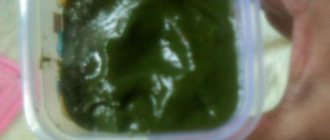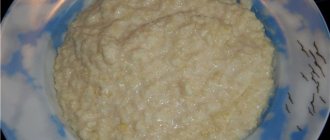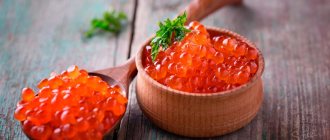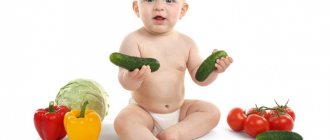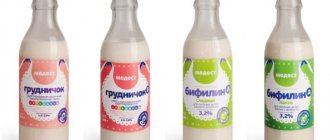When to introduce porridge complementary foods
The need for this kind of complementary feeding arises only after the child has completely become accustomed to the primary product of complementary feeding - vegetable puree. This time comes no earlier than 3 weeks from the moment of its introduction.
But there are exceptions to this rule, which appear in conditions where the child experiences problems with weight gain, regurgitation, or unstable stools that tend to liquefy. In such situations, pediatricians advise forgetting about vegetable purees and starting the first complementary feeding with porridge.
Children growing up on breastfeeding are recommended to start complementary feeding with cereal products from 6 months. Those who use artificial ones need to start introducing them into the nutritional system already at 4 or 5 months of life.
Menu for a 7 month old baby
At 7 months, the volume of complementary foods introduced at 5 and 6 months increases. Yolk also appears in the child’s diet.
Approximate diet plan for 7 months
6.00 – breast milk/formula, 200 ml.
10.00 – dairy-free porridge, 150 g; supplementary feeding with breast milk/formula at the baby's request.
14.00 – vegetable puree, 170 g; meat, 30 g; quarter yolk, supplement with breast milk/formula as desired.
18.00 – cottage cheese, 40 g; fruit, 40 g; breast milk/formula, 200 ml.
22.00 – breast milk/formula, 200 ml.
Night feeding (at the baby’s request) – breast milk/formula, 200 ml.*
The total volume of the mixture per day is up to 1000 ml.
You can add butter or vegetable oil to vegetables and porridge.
*Breastfed children do not eat by the hour, but on demand. However, as a rule, by this age they have formed a constant diet.
What types of baby cereals are suitable for first feeding?
It turns out that not all cereals can be given to babies, since some of them can do more harm than good to their fragile digestive system. Therefore, it is important for young mothers to know which cereals can be given to a child at 6 months, and which ones are better offered at an older age.
Gluten-free cereals are the best option for feeding a 6-month-old baby, as they do not cause digestive problems.
Gluten is a complex protein of plant origin found in a large number of cereals. It is difficult to digest not only in babies 6 months old, but also in older children. It's all about the peculiarities of the development of the enzymatic function of the gastrointestinal tract. Difficulty digesting gluten results in increased gas, bloating, or abdominal pain. Moreover, sometimes problems with digesting this protein do not go away with age, but last throughout life due to a hereditary disease known as celiac disease. For this disease, a special diet is prescribed and treatment is required. Gluten is also often called gluten.
Cereals that do not contain gluten include:
- corn,
- rice,
- buckwheat
List of cereals that contain gluten:
- millet,
- millet,
- rye,
- oats,
- barley.
It follows that the introduction of complementary foods from 6 months is possible with three types of porridges: corn, rice and buckwheat.
But this does not mean that we have determined the best diet for a 6-month-old baby. Porridge for a 6-month-old child should be selected individually, taking into account the process of its absorption. For example, if the baby suffers from unstable stools, then complementary feeding should be started with rice or corn porridge. If you have constipation, you should exclude foods made from rice cereal from your diet. In such cases, preference is given to buckwheat, which is rich in fiber and can also stimulate digestion.
It is worth noting that buckwheat porridge is quite nutritious and contains a large amount of iron and mineral salts, and this provides considerable benefits to children suffering from iron deficiency anemia.
Lure. Porridge. We cook ourselves
What cereals are best for first feeding?
Porridges for complementary feeding from 6 months should not contain gluten. This substance is poorly tolerated by young children. Gluten-free options include rice, buckwheat and corn. Also, products should not contain artificial additives.
Buckwheat
It is better to start the first complementary feeding at six months with buckwheat. This product is rich in iron, magnesium, calcium, potassium, cobalt, sodium, zinc. It contains vitamins B, E, PP and protein.
Benefits of buckwheat porridge for infants:
- strengthening the immune system . This property is due to the presence of rutin in the cereal. It is a flavonoid that increases the effect of vitamin C. Regular consumption of buckwheat reduces the risk of colds and acute respiratory infections;
- building muscle mass . Achieved due to the presence of protein and complex carbohydrates in the product;
- prevention of anemia . Cereals replenish iron deficiency. A deficiency of this element can lead to weakened immunity and the development of chronic fatigue;
- normalization of the stomach and intestines . This quality is explained by the presence of fiber in buckwheat. Dietary fiber activates metabolic processes and intestinal function;
- strengthening the cardiovascular system . Achieved due to the presence of potassium in the product. This element strengthens the myocardium and improves its functioning.
Buckwheat is considered a hypoallergenic product. It provokes the development of an intolerance reaction less often than other cereals. But you shouldn’t overuse buckwheat porridge. This can cause flatulence and intestinal inflammation.
Preference should be given to dairy-free unsweetened cereals. Milk contains casein protein, which can cause a severe allergic reaction in a child.
Rice
Pediatricians recommend rice for first feeding for those children who are underweight and prone to diarrhea. This product contains a lot of dietary fiber.
Porridge for first feeding is prepared from rice flour
Some mothers think that rice porridge can cause constipation, so they are afraid to include it in their child’s diet. But this is a mistaken opinion. Digestive problems are caused by dishes made from broken rice. Rice flour does not have such side effects on the body.
The product contains a lot of vitamins and minerals.
Rice contains phosphorus, zinc, potassium, iron, sodium, manganese, selenium, magnesium, and iodine. Vitamins B, K, and E are present in sufficient quantities. The composition of rice determines the presence of the following beneficial properties:
- building muscle mass;
- toning the body;
- ensuring normal intellectual development;
- removal of harmful substances from the body;
- strengthening nails, hair, bones;
- improvement of skin condition;
- ensuring proper formation of the central nervous system.
Rice components do not cause irritation to the gastric and intestinal mucosa. They have enveloping properties. The product is hypoallergenic and easily digestible.
Corn
Corn is very healthy. It contains a lot of fiber, minerals, and protein. It contains calcium, sodium, iron, selenium, manganese, sulfur, potassium, copper, zinc, phosphorus. Corn is absorbed and digested quite quickly.
Corn has the following beneficial qualities:
- cleansing the body of toxins;
- stimulation of the immune system;
- ensuring proper formation of bone tissue;
- strengthening teeth, hair, nails;
- prevention of anemia;
- improvement of the condition of the heart and blood vessels;
- decreased psycho-emotional arousal.
Pediatricians recommend introducing corn after buckwheat and rice. This product is especially useful for hyperactive children.
In what order should baby cereals be introduced from 6 months?
It was already mentioned earlier that porridges are eaten depending on individual characteristics. However, there is a certain algorithm for introducing cereals into the diet.
- 6-7 months. Corn, rice and buckwheat porridges have a beneficial effect on the intestines of children six and seven months old.
- 7-8 months. Starting from the seventh month and through the eighth, you can give oats and make some cereal combinations. This is possible provided that the child’s body has already passed the stage of adaptation to cereals of this kind.
- 9-10 months. Rye, barley and millet should be introduced into the children's menu during this period.
As for semolina porridge, it should not be consumed by children under 1 year of age, as it weakens the process of calcium absorption, which affects the formation of rickets. It is worth noting that semolina contains a lot of gluten and almost does not contain any vitamins or microelements.
Rules for feeding a baby at 6 months
Until the age of six months, the main food for the baby is breast milk or formula if he is bottle-fed. From mother's milk, the baby receives all the necessary vitamins and microelements. There is no benefit from earlier complementary feeding. You can only get unpleasant consequences in the form of food allergies or stool disorders.
Upon reaching 6 months, mother's milk no longer meets the baby's needs. This is the period when the baby begins to move. To ensure normal growth, it requires more calories, micronutrients, and iron. Of course, mother's milk remains the main nutritional product, but the time has come to introduce complementary foods.
Sometimes not all children are ready to switch to solid food at 6 months. It is believed that food experiments can begin if the child:
- holds the head independently for a long time;
- sits himself;
- shows interest in food and puts it into his mouth with pleasure if it is offered to him.
If a child at 6 months does not show any interest in new food, then there is no need to rush. All children are individual. Wait a few weeks, then offer the product to your baby again.
Amount of porridge feeding at 6 months
Before calculating portions, you first need to understand the process of introducing complementary foods.
To easily get used to cereals that were not previously included in the diet, it is necessary to give five percent porridge, which is prepared as follows: 5 grams of cereal per 100 grams of water.
- 1 Week. It is recommended to start complementary feeding with 1 teaspoon, increasing it to 150 milliliters over 7-10 days.
- Week 2. If there are no problems with the perception of porridge, i.e. If no skin rashes or stool disturbances are observed, then ten percent porridge is introduced into use. The input period is also 7-10 days.
- In the third week of complementary feeding, the final stage begins. Here the child must fully adapt to the incoming food product. And only then is a new cereal introduced in the form of ten percent porridge.
We conclude that at 6 months a child needs 150 milliliters of porridge, but in the future the portions need to be increased. So at 7-8 months the volume reaches 160-170 milliliters, at 8-9 – 170-180 ml, and after 9 months it reaches 200 ml.
The first four days, the increase in the daily intake of porridge occurs by 5 g and reaches 20 grams by the final day; on the fifth day you can already offer 50 g, on the sixth - 100 g, and on the seventh - 150 g.
Menu for a 6 month old baby
At 6 months, the child’s diet includes 1–2 types of porridge, 2 types of single-component vegetable puree (broccoli, zucchini, cauliflower), meat puree and baby cottage cheese.
Approximate diet plan for 6 months
6.00 – breast milk/formula, 200 ml.
10.00 – dairy-free porridge, 10–150 g (depending on the stage of introduction of complementary foods); supplementary feeding with breast milk/formula at the baby's request.
14.00 – vegetable puree, 10–150 g; meat, 5–30 g (depending on the stage of introduction of complementary foods); supplementary feeding with breast milk/formula as desired.
18.00 – cottage cheese, 10–40 g; fruit, 40 g; breast milk/formula, 200 ml.
22.00 – breast milk/formula, 200 ml.
Night feeding (at the baby’s request) – breast milk/formula, 200 ml.*
The total volume of the mixture per day is up to 1000 ml.
*Breastfed children do not eat by the hour, but on demand. However, as a rule, by this age they have formed a constant diet.
